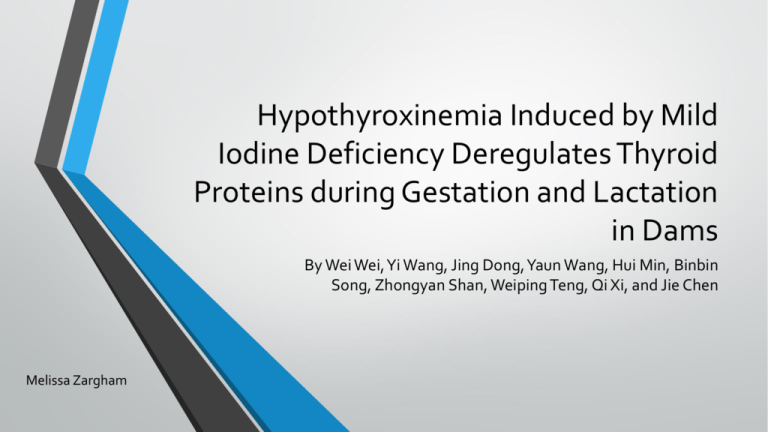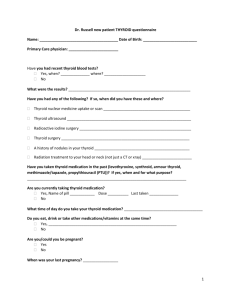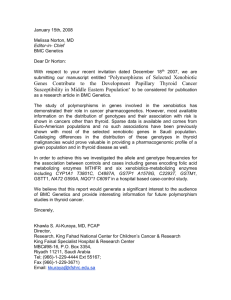Iodine Deficiency presentation
advertisement

Hypothyroxinemia Induced by Mild Iodine Deficiency Deregulates Thyroid Proteins during Gestation and Lactation in Dams By Wei Wei, Yi Wang, Jing Dong, Yaun Wang, Hui Min, Binbin Song, Zhongyan Shan, Weiping Teng, Qi Xi, and Jie Chen Melissa Zargham Purpose • The object of the study was to explore the effect of mild iodine deficiencyinduced maternal hypothyroxinemia during pregnancy and lactation on thyroidal proteins. • Importance: Maternal iodine deficiency during pregnancy and lactation results in decreased IQ in children. Introduction • Iodine = essential trace element for the thyroid • Produces triiodothyronine (T3) and thyroxine (T4) • Iodine deficiency (ID) can lead to • • Hypothyrodism Hypothyroxinemia • Mild ID is recognized as the most common reason causing hypothyroxinemia Introduction • Thyroid and Thyroid function: • • Thyroid transcription factor 1 (TTF1) Paired box gene 8 (PAX8) • Thyroid hormone • • Type 1 iodothyronine deiodinase (DIO1) Type 2 iodothyronine deiodinase (DIO2) Background • Thyroid Hormone Synthesis • • • • • Iodide (I-) actively taken up into the thyroid cells Iodide is oxidized to iodine and bound to the tyrosyl residues of thyroglobulin forming thyroglobulin-3-monoiodotyrosine (Thg-MIT) MIT is iodinated in the 5th position forming ThgDIT Two DITs couple to form Thg-T4. DIT also couples with MIT to form T3 Thg-T4 and Thg-T3 are hydrolyzed by lysosomal proteases and T4 and T3 are released into blood Hypothesis • Mild ID diet may induce mild ID by impacting the expressions of thyroidal TTF1, PAX8, and NIS. In gestational and lactational dams, mild ID may induce hypothyroxinemia and disturb thyroidal DIO1 and DIO2 expressions. Methods • • • • Female Wistar rats Three groups: • • • Control group ( iodine intake of 7.0 μg/day) Mild ID group (iodine intake of 3.0 μg/day) Severe ID group (iodine intake of 1.5 μg/day) Blood was obtained and tested via a supersensitive chemiluminescence immunoassay Mated with normal male rats Methods • Measurement of Thyroid Iodine Content: • • • Thyroid glands were collected from 5 dams on gestational day (GD)19 and postpartum day (PN) 21 Measured by ammonium persulfate-arsenic cerium catalytic spectrophotometry Western Blotting • • • Rats were euthanized Thyroid gland tissue was collected Chemiluminescence Results • • Thyroid Iodine Content: Thyroid gland weight significantly increased in mild and severe ID Western Blotting: Western Blotting Results Results DIO1 DIO2 Discussion/Conclusion • • • • Major findings: • Increased thyroid weights, decreased thyroid iodine contents and up-regulation of thyroidal TTF1, PAX8, NIS, DIO1 and DIO2 Hypothyroidism induced by severed ID not common but hypothyroxinemia still prevalent Maternal hypothyroxinemia may lead to irreversible CNS damage in humans. Results showed that, in the gestational and lactational dams, the maternal mild ID diet could cause mild ID by impacting thyroidal TTF1, PAX8, and NIS. Also, hypothyroxinemia induced by mild ID increased the levels of DIO1 and DIO2. Resources • Western Blotting Image http://www.piercenet.com/guide/fast-westernblotting-product-selection-guide • Wei, W., Wang, Y., Dong, J., Wang, Y., Min, H., Song, B., . . . Chen, J. (2013). Hypothyroxinemia induced by mild iodine deficiency deregulats thyroid proteins during gestation and lactation in dams. International Journal of Environmental Research and Public Health, 10(8), 3233-45. Retrieved from http://search.proquest.com/docview/1468936671?accountid=13645 • Gropper, S & Smith, J. Essential Trace and Ultratrace Minerals. Advanced Nutrition and Human Metabolism (6th ed.). (pp.531-533). Belmont: Wadsworth Cengage Learning.






